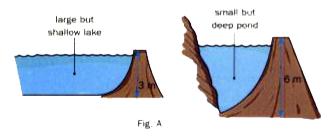Explain atmospheric pressure. On what factors does it depend and how?
Step-by-Step Solution:
1. Definition of Atmospheric Pressure:
Atmospheric pressure is defined as the pressure exerted by the weight of the air above a certain point in the Earth's atmosphere. It is the result of the gravitational pull on the air molecules that make up the atmosphere.
2. Factors Affecting Atmospheric Pressure:
Atmospheric pressure depends on several factors, primarily:
- Height (Altitude): As you ascend in altitude, the amount of air above you decreases, leading to a reduction in pressure. Thus, atmospheric pressure decreases with an increase in height.
- Gravity: Atmospheric pressure is also influenced by the force of gravity. The formula for pressure is given by P=FA, where F is the force (weight of the air) and A is the area. If gravity decreases, the weight of the air also decreases, resulting in lower atmospheric pressure.
- Temperature: The absolute temperature of the air can also affect atmospheric pressure. Generally, as temperature increases, the air expands and becomes less dense, which can lead to a decrease in pressure.
3. Explanation of Each Factor:
- Height: At sea level, the atmospheric pressure is highest because there is a greater column of air above. As you go higher, such as in mountains, there is less air above you, leading to lower pressure.
- Gravity: The gravitational force affects how much the air weighs. If you were on a planet with weaker gravity, the air would weigh less, resulting in lower atmospheric pressure.
- Temperature: When the temperature rises, air molecules move faster and spread apart, causing the air to become less dense. This decrease in density can lead to a reduction in pressure.
Summary:
Atmospheric pressure is the pressure exerted by the weight of the air in the atmosphere, and it depends on height, gravity, and temperature. As height increases, atmospheric pressure decreases; as gravity decreases, atmospheric pressure also decreases; and as temperature increases, atmospheric pressure may decrease due to the expansion of air.
Atmospheric pressure is defined as the pressure exerted by the weight of the air above a certain point in the Earth's atmosphere. It is the result of the gravitational pull on the air molecules that make up the atmosphere.
Atmospheric pressure depends on several factors, primarily:
- Height (Altitude): As you ascend in altitude, the amount of air above you decreases, leading to a reduction in pressure. Thus, atmospheric pressure decreases with an increase in height.
- Gravity: Atmospheric pressure is also influenced by the force of gravity. The formula for pressure is given by P=FA, where F is the force (weight of the air) and A is the area. If gravity decreases, the weight of the air also decreases, resulting in lower atmospheric pressure.
- Temperature: The absolute temperature of the air can also affect atmospheric pressure. Generally, as temperature increases, the air expands and becomes less dense, which can lead to a decrease in pressure.
- Height: At sea level, the atmospheric pressure is highest because there is a greater column of air above. As you go higher, such as in mountains, there is less air above you, leading to lower pressure.
- Gravity: The gravitational force affects how much the air weighs. If you were on a planet with weaker gravity, the air would weigh less, resulting in lower atmospheric pressure.
- Temperature: When the temperature rises, air molecules move faster and spread apart, causing the air to become less dense. This decrease in density can lead to a reduction in pressure.
Atmospheric pressure is the pressure exerted by the weight of the air in the atmosphere, and it depends on height, gravity, and temperature. As height increases, atmospheric pressure decreases; as gravity decreases, atmospheric pressure also decreases; and as temperature increases, atmospheric pressure may decrease due to the expansion of air.
टॉपर्स ने हल किए ये सवाल
- FORCE AND PRESSURE Book:ICSEChapter:FORCE AND PRESSURE Exercise:Exercises (Section II) Numerical questions
Explore 10 Videos
- FORCE AND PRESSURE Book:ICSEChapter:FORCE AND PRESSURE Exercise:Picture Study
Explore 4 Videos
- FORCE AND PRESSURE Book:ICSEChapter:FORCE AND PRESSURE Exercise:Exercises (Section II) Short answer questions
Explore 6 Videos
- ENERGYBook:ICSEChapter:ENERGYExercise:THEME ASSIGNMENT
Explore 4 Videos
- HEAT TRANSFER Book:ICSEChapter:HEAT TRANSFER Exercise:Picture Study
Explore 2 Videos
समान प्रश्न
The breadth of an iron door is 2.4 m. If the minimum torque required to open the door is 50 Nm, what is the minimum force required to open the door?
View SolutionA shallow lake and a deep pond are shown in Figure A. Which of them will have greater pressure at the bottom. Give reason.

View SolutionWhat are the two factors that affect the moment of force, and how?
View Solution(a) Describe potential energy and kinetic energy with proper examples.
(b) State difference between energy and power.
View SolutionWhat kind of expansion is taking place in the figures given here ? Write your answers in the space provided ?

View SolutionHow does the speed v of sound in air depend on the atmospheric pressure P?
View SolutionOn what factors does the fluid pressure depend ?
View Solutionकिसी ग्रह पर वायुमण्डल का होना किन तथ्यों पर निर्भर करता है ?
View SolutionState the factors on which the atmospheric pressure at a place depends.
View SolutionDefine osmotic pressure. How does it depend upon the temperature and atmospheric pressure ?
View SolutionWhat factors does the pressure on a page depend on?
View SolutionOn what factors does the pressure of any place depends ?
View SolutionUpon what factors pressure depends ?
View SolutionOn what factors the attraction between two objects depend? Explain how they depend?
View SolutionWhat is blood pressure? How is it measured? Explain factors affecting blood pressure.
View Solution